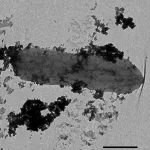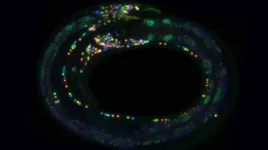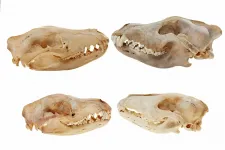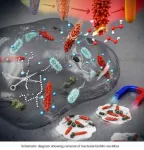How 'Iron Man' bacteria could help protect the environment
MSU researchers show how microbes stand up to a toxic metal, opening the door for applications in recycling and remediation
2021-01-08
(Press-News.org) When Michigan State University's Gemma Reguera first proposed her new research project to the National Science Foundation, one grant reviewer responded that the idea was not "environmentally relevant."
As other reviewers and the program manager didn't share this sentiment, NSF funded the proposal. And, now, Reguera's team has shown that microbes are capable of an incredible feat that could help reclaim a valuable natural resource and soak up toxic pollutants.
"The lesson is that we really need to think outside the box, especially in biology. We just know the tip of the iceberg. Microbes have been on earth for billions of years, and to think that they can't do something precludes us from so many ideas and applications," said Reguera, a professor in the Department of Microbiology and Molecular Genetics.
Reguera's team works with bacteria found in soil and sediment known as Geobacter. In its latest project, the team investigated what happened to the bacteria when they encounter cobalt.
Cobalt is a valuable but increasingly scarce metal used in batteries for electric vehicles and alloys for spacecraft. It's also highly toxic to livings things, including humans and bacteria.
"It kills a lot of microbes," Reguera said. "Cobalt penetrates their cells and wreaks havoc."
But the team suspected Geobacter might be able to escape that fate. These microbes are a hardy bunch. They can block uranium contaminants from getting into groundwater, and they can power themselves by pulling energy from minerals containing iron oxide. "They respire rust," Reguera said.
Scientists know little about how microbes interact with cobalt in the environment, but many researchers -- including one grant reviewer -- believed that the toxic metal would be too much for the microbes.
But Reguera's team challenged that thinking and found Geobacter to be effective cobalt "miners," extracting the metal from rust without letting it penetrate their cells and kill them. Rather, the bacteria essentially coat themselves with the metal.
"They form cobalt nanoparticles on their surface. They metallize themselves and it's like a shield that protects them," Reguera said. "It's like Iron Man when he puts on the suit."
The team published its discovery in the journal Frontiers in Microbiology, with the research article first appearing online in late November, 2020. The Spartan team included Kazem Kashefi, an assistant professor in the Department of Microbiology and Molecular Genetics, and graduate students Hunter Dulay and Marcela Tabares, who are "two amazing and relatively junior investigators," Reguera said.
She sees this discovery as a proof-of-concept that opens the door to a number of exciting possibilities. For example, Geobacter could form the basis of new biotechnology built to reclaim and recycle cobalt from lithium-ion batteries, reducing the nation's dependence on foreign cobalt mines.
It also invites researchers to study Geobacter as a means to soak up other toxic metals that were previously believed to be death sentences for the bacteria. Reguera is particularly interested in seeing if Geobacter could help clean up cadmium, a metal that's found in industrial pollution that disproportionately affects America's most disadvantaged communities.
"This is a reminder to be creative and not limited in the possibilities. Research is the freedom to explore, to search and search and search," Reguera said. "We have textbook opinions about what microbes can and should do, but life is so diverse and colorful. There are other processes out there waiting to be discovered."
INFORMATION:
This work was supported by the NSF's Geobiology and Low-Temperature Geochemistry Program, as well as a Hatch project grant from the United States Department of Agriculture's National Institute of Food and Agriculture.
(Note for media: Please include a link to the original paper in online coverage: https://doi.org/10.3389/fmicb.2020.600463)
[Attachments] See images for this press release:

ELSE PRESS RELEASES FROM THIS DATE:
2021-01-08
Maize has a significantly higher productivity rate compared with many other crops. The particular leaf anatomy and special form of photosynthesis (referred to as 'C4') developed during its evolution allow maize to grow considerably faster than comparable plants. As a result, maize needs more efficient transport strategies to distribute the photoassimilates produced during photosynthesis throughout the plant.
Researchers at HHU have now discovered a phloem loading mechanism that has not been described before - the bundle sheath surrounding the vasculature as the place for the actual transport of compounds such as sugars or amino acids. The development of this mechanism could have been ...
2021-01-08
A unifying explanation of the cause of autism and the reason for its rising prevalence has eluded scientists for decades, but a theoretical model published in the journal Medical Hypotheses describes the cause as a combination of socially valued traits, common in autism, and any number of co-occurring disabilities.
T.A. Meridian McDonald, PhD, a research instructor in Neurology at Vanderbilt University Medical Center, has spent 25 years researching autism, from a time she could read literally every research paper on the topic in the 1990s until now, when there is an overload of such studies.
"Up until now there have been a lot of theories about the possible causes ...
2021-01-08
In a letter published in the December issue of the American Heart Association's medical journal Circulation a group of researchers at Vanderbilt University Medical Center (VUMC) dispute the most recent findings of the incidence of myocarditis in athletes with a history of COVID-19.
The Vanderbilt study, COVID-19 Myocardial Pathology Evaluation in AthleTEs with Cardiac Magnetic Resonance (COMPETE CMR), found a much lower degree of myocarditis in athletes than what was previously reported in other studies.
"The differences in the findings are extremely important. The whole world paused after seeing the alarmingly high rates of myocardial inflammation and edema initially published," said ...
2021-01-08
Across the world, health care workers and high-risk groups are beginning to receive COVID-19 vaccines, offering hope for a return to normalcy amidst the pandemic. However, the vaccines authorized for emergency use in the U.S. require two doses to be effective, which can create problems with logistics and compliance. Now, researchers reporting in ACS Central Science have developed a nanoparticle vaccine that elicits a virus-neutralizing antibody response in mice after only a single dose.
The primary target for COVID-19 vaccines is the spike protein, which is necessary for SARS-CoV-2's entry into ...
2021-01-08
In 2020, astronomers added a new member to an exclusive family of exotic objects with the discovery of a magnetar. New observations from NASA's Chandra X-ray Observatory help support the idea that it is also a pulsar, meaning it emits regular pulses of light.
Magnetars are a type of neutron star, an incredibly dense object mainly made up of tightly packed neutron, which forms from the collapsed core of a massive star during a supernova.
What sets magnetars apart from other neutron stars is that they also have the most powerful known magnetic fields in the universe. For context, the strength of our planet's magnetic field has a value of about one Gauss, while a refrigerator magnet measures about ...
2021-01-08
UC San Francisco scientists have discovered a new way to control the immune system's "natural killer" (NK) cells, a finding with implications for novel cell therapies and tissue implants that can evade immune rejection. The findings could also be used to enhance the ability of cancer immunotherapies to detect and destroy lurking tumors.
The study, published January 8, 2021 in the Journal of Experimental Medicine, addresses a major challenge for the field of regenerative medicine, said lead author Tobias Deuse, MD, the Julien I.E. Hoffman, MD, Endowed Chair in Cardiac Surgery in the UCSF Department of Surgery.
"As a cardiac surgeon, I would love to put myself out of business by being able to implant healthy cardiac ...
2021-01-08
The SARS-CoV-2 virus was introduced to the United Kingdom well over 1,000 times in early 2020, according to researchers who analyzed more than 50,000 viral sequences from the first wave of the COVID-19 pandemic in the UK. The virus lineages introduced before the UK's national lockdown in March tended to be larger and more geographically dispersed. Infectious disease epidemics are composed of chains of transmission, yet little is known about how co-circulating transmission lineages vary in size, spatial distribution and persistence. Understanding these features could help target interventions, track variants with different impacts on their human hosts, and more. The UK's COVID-19 epidemic during early 2020 was one of the world's largest. It was also well represented by virus genomic sampling, ...
2021-01-08
The human brain contains approximately 86 billion neurons, or nerve cells, woven together by an estimated 100 trillion connections, or synapses. Each cell has a role that helps us to move muscles, process our environment, form memories, and much more.
Given the huge number of neurons and connections, there is still much we don't know about how neurons work together to give rise to thought or behavior.
Now Columbia scientists have engineered a coloring technique, known as NeuroPAL (a Neuronal Polychromatic Atlas of Landmarks), which makes it possible--at least in experiments with Caenorhabditis elegans (C. elegans), a worm species commonly used in biological ...
2021-01-08
Micro-CT scanning and digital reconstructions have been used to compare the skulls of the Tasmanian tiger (thylacine) and wolf across their early development and into adulthood, establishing that not only did the thylacine resemble the wolf as adults, but also as newborns and juveniles.
"Remarkably, the Tasmanian tiger pups were more similar to wolf pups than to other closely related marsupials," Professor Andrew Pask from the University of Melbourne said.
The collaborative study with Flinders University and Museums Victoria complement earlier findings that thylacine and wolf have evolved similar instructions in their genome, which influence cranial stem cells during development.
While ...
2021-01-08
The COVID-19 pandemic is raising fears of new pathogens such as new viruses or drug-resistant bacteria. To this, a Korean research team has recently drawn attention for developing the technology for removing antibiotic-resistant bacteria by controlling the surface texture of nanomaterials.
A joint research team from POSTECH and UNIST has introduced mixed-FeCo-oxide-based surface-textured nanostructures (MTex) as highly efficient magneto-catalytic platform in the international journal Nano Letters. The team consisted of professors In Su Lee and ...
LAST 30 PRESS RELEASES:
[Press-News.org] How 'Iron Man' bacteria could help protect the environment
MSU researchers show how microbes stand up to a toxic metal, opening the door for applications in recycling and remediation







